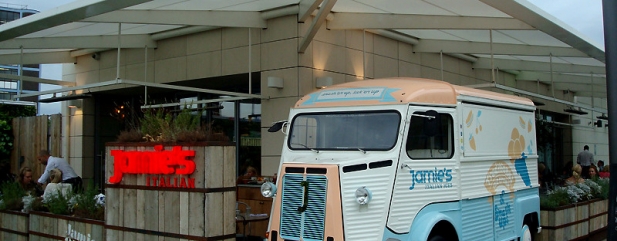Archived article
Please note that tax, investment, pension and ISA rules can change and the information and any views contained in this article may now be inaccurate.
What you need to know about the future of restaurants

Last week saw the final collapse of Jamie Oliver’s restaurant empire after a year of struggling with mounting debts and insufficient funds. As one of the administrators from KPMG observed, the casual-dining environment is ‘as tough as I’ve ever seen’.
It seems a far cry from the start of the decade when affordable restaurants were popping up on every high street on a weekly basis. With rising pressure on consumer spending and tastes changing rapidly, what do restaurants have to do to survive in today’s market?
CHRONICLE OF FORETOLD DEATH
Jamie Oliver’s restaurant empire was just the latest in a succession of casual-dining chains to run into difficulties. Last year Prezzo and Strada went into administration and Carluccio’s went into a company voluntary agreement (CVA) to dispose of loss-making sites and negotiate lower rents.
Byron also closed its doors after taking the market by storm just ten years earlier, while rival Gourmet Burger Kitchen began shuttering around a quarter of its restaurants last year after it filed for a CVA.
While the troubles of the high street are well-documented, the focus has been on retailers and pubs not restaurants. The government is working on a plan to bring shoppers back and has set money aside to transform disused pubs, but it looks as though restaurants are on their own.
TIMES HAVE CHANGED
From 2010 until a few years ago, our appetite for affordable dining-out seemed insatiable. Restaurants opened at an unprecedented pace, often with little regard to cost thanks to cheap debt and landlords eager to let vacant space.
A 2016 poll put eating out as our favourite leisure activity, but the combination of stagnant wages and falling consumer confidence since the referendum has shifted the goalposts, seemingly for good.
We’re going out less, and we’re spending less. The latest Coffer Peach business tracker, which gathers sales figures from 50 pub and restaurant groups with a combined annual turnover of £9bn, shows like for like sales over the four-day Easter weekend down 3.6% for the eating- and drinking-out market, with restaurant sales down a massive 19.4% compared with Easter last year.
TASTES HAVE CHANGED, TOO
While distinctive brands such as Nando’s and Wagamama will probably survive as fashions come and go, and this explains the presence of Wagamama-owner Restaurant Group (RTN) in our list of Great Ideas, there have been major changes to our eating habits over the last decade.
One in three of us eats less red meat than ten years ago, or none at all, while one in eight of us is now vegan or vegetarian.
The success of the Beyond Meat and Impossible public offerings in the US would suggest that veganism is not a short-lived fad. Closer to home, Pret’s takeover of failing rival Eat and the transformation of its stores into Pret Veggie outlets is another clear sign of the times.
SUSTAINABILITY AND SOCIAL MEDIA IMPACT
As consumers we are more informed and more concerned about the environment and our impact on it than ever before. From single-use plastic to impact investing and sustainable resources, consumers are increasingly dictating the agenda to politicians and businesses rather than vice versa.
For restaurants, sustainability ratings which score on environmental impact, sustainable sources, carbon footprint and waste could become as important as Tripadvisor ratings according to consultancy Think Hospitality.
Pret’s veggie outlets already have small hydroponic gardens growing basil and other herbs for their meals. Meanwhile laboratory-grown meat is being discussed as a genuine alternative to farmed meat which is notoriously bad for the environment in terms of land, water and energy intensity, not to mention the use of pesticides and herbicides.
Consumers, especially millennials, have been focusing their discretionary spending on experiences rather than ‘stuff’ for some time. In a 2018 Barclaycard survey over half of consumers said they would rather spend money on entertainment than possessions.
The impact of social media on spending patterns is immense and just as retailers can tailor their offerings based on data they have about customers, so our social media data could mean tailored recommendations of restaurants, times to dine and even dishes based on our personal preferences.
A TRULY PERSONALISED EXPERIENCE
Along with the increasing trend towards healthy eating, the use of technology, and in particular AI, could see menus and dishes ‘personalised’ so that what we eat is aligned to our need state, blood type or even DNA.
The Yo! Sushi chain has partnered with a DNA testing firm to offer personalised DNA dining. The customer completes a DNA swab test and a dedicated ‘plate plan’ is produced with specific items selected according to genetic profiling.
Scientists are even working on swallowable sensors which will monitor gut health, stimulate damaged tissue or be used to target drug delivery. These sensors could also be used to monitor glucose, nutrient, sugar and alcohol levels in food and with RFID could communicate the information to a mobile phone.
The restaurant of the future will have to know a lot more about its customers than the restaurant of today if it wants to stay successful.
Important information:
These articles are provided by Shares magazine which is published by AJ Bell Media, a part of AJ Bell. Shares is not written by AJ Bell.
Shares is provided for your general information and use and is not a personal recommendation to invest. It is not intended to be relied upon by you in making or not making any investment decisions. The investments referred to in these articles will not be suitable for all investors. If in doubt please seek appropriate independent financial advice.
Investors acting on the information in these articles do so at their own risk and AJ Bell Media and its staff do not accept liability for losses suffered by investors as a result of their investment decisions.

 magazine
magazine









